Clavicle fractures
What is the clavicle?
The clavicle, commonly called the "collarbone", forms a strut that connects the rib cage to the scapula ("shoulder blade"). The clavicle is important because it stabilizes the shoulder joint and the upper extremity. At its distal end, the clavicle forms a joint with the acromion (a part of the scapula). This joint is called the acromioclavicular (AC) joint. At the proximal end, the clavicle forms a joint with the sternum called the sternoclavicular (SC) joint. Both of these joints may be injured or dislocated, but a clavicle fracture combined with an AC or SC joint dislocation is rare. Near the AC joint there are two ligaments that connect the distal clavicle to the coracoid (another part of the scapula), the coracoclavicular ligaments. These ligaments help stabilize the connection between the clavicle and the scapula.
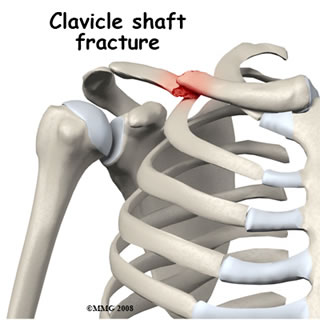
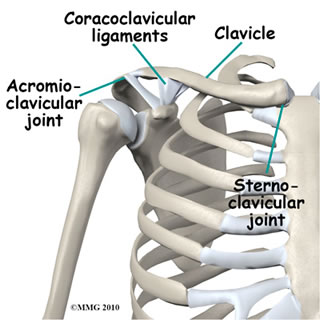
What are the symptoms?
A fracture of the clavicle causes pain and swelling in the collarbone area. You will probably not be able to raise the arm. There is usually bleeding into the tissues around the fracture. After several days, there may be intense purple bruising (ecchymosis) around the shoulder and down the arm. This is to be expected and you should not necessarily be alarmed. Swelling may occur from the shoulder to the hand. You may feel the bone fragments shift as you move and should not be alarmed if this occurs. You may be able to see the end of one or more fracture fragments pushing outward and stretching (tenting) the skin. In some cases the fracture fragment may pierce the skin, turning the fracture into an open fracture (also called a compound fracture).
How is it diagnosed?
The primary goal of the clinical evaluation of a clavicle fracture is to determine the fracture pattern: what area of the bone has been fractured, how many fragments of bone there are, and how far those fragments are separated (or displaced). This can be determined by taking several x-rays of the clavicle and shoulder. Sometimes further scans such as a CT scan are required. Your doctor will also want to make sure that there has been no damage to the nerves and blood vessels that travel under the clavicle and out to the arm. This can usually be accomplished with a careful physical examination.
What is the treatment?
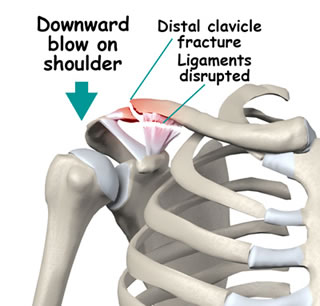 Most clavicle fractures are treated without surgery. The fracture pattern will largely determine whether your surgeon will suggest treating the fracture with or without surgery. Most clavicle fractures occur in the middle third of the bone. These have an excellent chance of healing without surgery. Fractures at the end of the bone near the shoulder are more complicated because of the AC joint and the ligaments that connect the clavicle to the scapula. Fractures in this area may require surgery.
Most clavicle fractures are treated without surgery. The fracture pattern will largely determine whether your surgeon will suggest treating the fracture with or without surgery. Most clavicle fractures occur in the middle third of the bone. These have an excellent chance of healing without surgery. Fractures at the end of the bone near the shoulder are more complicated because of the AC joint and the ligaments that connect the clavicle to the scapula. Fractures in this area may require surgery.
Occasionally the fracture fragments may fail to heal; this is referred to as a nonunion. This is much more likely if you smoke. The fracture fragments may also heal in an unacceptable alignment; this is called malunion. Both of these complications may result in pain, loss of strength, and a decreased range of motion of the shoulder. An operation may be needed to treat this.
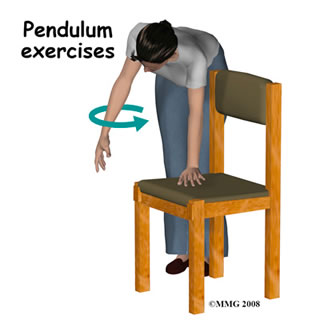 Non-surgical treatment:
Non-surgical treatment:
If your doctor makes the assessment that the fracture will heal and give you good shoulder function without surgery, nonsurgical treatment will be recommended. Nonsurgical treatment of clavicle fractures generally requires a sling or a special type of sling called a shoulder immobilizer. The shoulder immobilizer supports the weight of the arm to keep the shoulder girdle and arm from pulling the fracture fragments further out of alignment. You may feel the bone fragments shift as you move; this usually stops by the third week after the fracture.
Your rehabilitation exercises will begin as soon as you can tolerate motion with very gentle exercises (pendulum exercises) designed to regain motion. Once the fracture has healed enough strengthening exercises will be added to your rehabilitation program. This may occur at six to eight weeks.
Surgical treatment:
Some clavicle fractures may need surgery. If your surgeon makes the assessment that the fracture will not heal and give you good shoulder function without surgery, surgical treatment will be recommended. Surgical treatment of clavicle fractures is usually performed with a metal plate and screws along the side of the bone. Open Reduction and Internal Fixation (ORIF) of clavicle fractures using a metal plate and screws is common. This type of treatment allows the fracture fragments to be restored as close to their normal position as possible and held there until healing occurs.
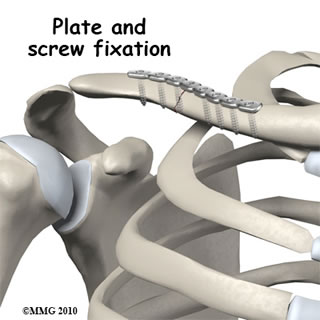 ORIF requires an incision over the area of the fracture. The clavicle is very superficial, meaning that the tissue covering the bone is not much more than the skin. In some thin individuals, the plate can be very prominent.
ORIF requires an incision over the area of the fracture. The clavicle is very superficial, meaning that the tissue covering the bone is not much more than the skin. In some thin individuals, the plate can be very prominent.
If the fracture is open, meaning there is a laceration that connects with the fracture, surgery is required to cleanse the fracture fragments and reduce the risk of infection. Infection is possible following any surgical procedure used to treat a fracture, but the risk is very low - less than one in a hundred. The risk is much higher if the fracture is an open fracture. An infection following surgery to repair a fracture may require additional surgery to remove the infected tissue and treatment with antibiotics
If surgery has been required, the rehabilitation program will be modified to protect the fixation of the fracture fragments. Your surgeon will communicate with your physiotherapist to make sure that your rehabilitation program does not risk causing the fixation to fail. If the surgeon feels that the fixation is very solid, you may be able progress your program quickly; if the fixation is not so solid, the speed at which you progress may need to be slowed until more healing occurs.
What is the prognosis?
The prognosis for clavicle fractures is generally excellent. The shoulder has the largest range of motion of any joint in the body. What this means if that even if the fracture fragments do not heal exactly in their normal position the shoulder joint can easily compensate and provide you with a well functioning shoulder joint.
